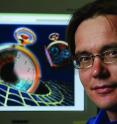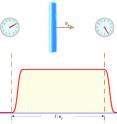Hiding in plain sight: Elusive dark matter may be detected with GPS satellites
Related images
(click to enlarge)
The everyday use of a GPS device might be to find your way around town or even navigate a hiking trail, but for two physicists, the Global Positioning System might be a tool in directly detecting and measuring dark matter, so far an elusive but ubiquitous form of matter responsible for the formation of galaxies. Andrei Derevianko, of the University of Nevada, Reno, and his colleague Maxim Pospelov, of the University of Victoria and the Perimeter Institute for Theoretical Physics in Canada, have proposed a method for a dark-matter search with GPS satellites and other atomic clock networks that compares times from the clocks and looks for discrepancies.
"Despite solid observational evidence for the existence of dark matter, its nature remains a mystery," Derevianko, a professor in the College of Science at the University, said. "Some research programs in particle physics assume that dark matter is composed of heavy-particle-like matter. This assumption may not hold true, and significant interest exists for alternatives."
"Modern physics and cosmology fail dramatically in that they can only explain 5 percent of mass and energy in the universe in the form of ordinary matter, but the rest is a mystery."
There is evidence that dark energy is about 68 percent of the mystery mass and energy. The remaining 27 percent is generally acknowledged to be dark matter, even though it is not visible and eludes direct detection and measurement.
"Our research pursues the idea that dark matter may be organized as a large gas-like collection of topological defects, or energy cracks," Derevianko said. "We propose to detect the defects, the dark matter, as they sweep through us with a network of sensitive atomic clocks. The idea is, where the clocks go out of synchronization, we would know that dark matter, the topological defect, has passed by. In fact, we envision using the GPS constellation as the largest human-built dark-matter detector."
Their research was well-received by the scientific community when the theory was presented at scientific conferences this year, and their paper on the topic appears today in the online version of the scientific journal Nature Physics, ahead of the print version.
Derevianko is collaborating on analyzing GPS data with Geoff Blewitt, director of the Nevada Geodetic Laboratory, also in the College of Science at the University of Nevada, Reno. The Geodetic Lab developed and maintains the largest GPS data processing center in the world, able to process information from about 12,000 stations around the globe continuously, 24/7.
The two are starting to test the dark matter detection ideas by analyzing clock data from the 30 GPS satellites, which use atomic clocks for everyday navigation. Correlated networks of atomic clocks such as the GPS and some ground networks already in existence, can be used as a powerful tool to search for the topological defect dark matter where initially synchronized clocks will become desynchronized. The time discrepancies between spatially separated clocks are expected to exhibit a distinct signature.
Blewitt, also a physicist, explained how an array of atomic clocks could possibly detect dark matter.
"We know the dark matter must be there, for example, because it is seen to bend light around galaxies, but we have no evidence as to what it might be made of," he said. "If the dark matter were not there, the normal matter that we know about would not be sufficient to bend the light as much as it does. That's just one of the ways scientists know there is a massive amount of dark matter somewhere out there in the galaxy. One possibility is that the dark matter in this gas might not be made out of particles like normal matter, but of macroscopic imperfections in the fabric of space-time.
"The Earth sweeps through this gas as it orbits the galaxy. So to us, the gas would appear to be like a galactic wind of dark matter blowing through the Earth system and its satellites. As the dark matter blows by, it would occasionally cause clocks of the GPS system to go out of sync with a tell-tale pattern over a period of about 3 minutes. If the dark matter causes the clocks to go out of sync by more than a billionth of a second we should easily be able to detect such events."

